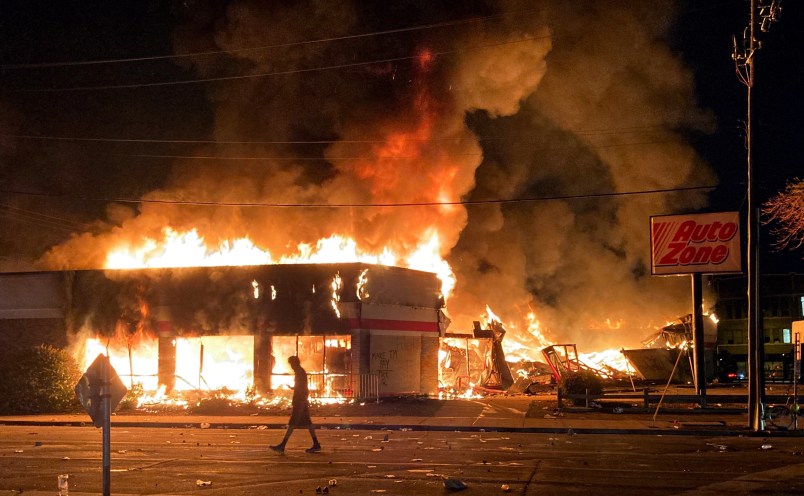If I were younger and living in Kenosha, Wisconsin, I would have been in the streets protesting the police shooting a Black man in the back as he got into a car with his three children already seated there. There may have been extraordinary extenuating circumstances, but based on the video, it would seem that this was as egregious an act as the killing of George Floyd and that the officers involved should be prosecuted and that the city’s police department dramatically reformed.
That said, I have extreme misgivings about the violent protests that have occurred over the last months and most recently in response to the Kenosha shooting. After night fell, protestors in Kenosha and Madison and as far away as Portland set fires and broke shop windows. Some looting also reportedly took place.
First, it’s a question of the politics in an election year when the president seeking re-election is Donald Trump. I haven’t needed to read Omar Wasow’s excellent research to know that violent rather than peaceful protests and rioting can lead to political consequences that undermine whatever the protestors had hoped to achieve. I lived in California during the ’60s when the conservative Republicans led by Ronald Reagan took over a government that had historically been run by progressive Republicans and Democrats.
Wasow argues that violent rather than peaceful protests in the ’60s contributed to the victory of Richard Nixon in 1968. The initial impact of the violent protests after Floyd’s murder suggested that they were not helping Donald Trump’s re-election this year, but I think that was largely because Trump overreacted — to put it mildly — in his staged event outside a church after he had enlisted troops to clear away peaceful protestors.
Trump and the Republicans may continue to overreact, but I wouldn’t count on it. As political scientist Michael Tesler has written in FiveThirtyEight, white support for Black Lives Matter, after an initial spurt in the wake of George Floyd’s murder, has begun to decline. It will continue to do so if late-night protestors continue to burn down government buildings and loot small businesses, while demanding that the police be defunded or even abolished.
Also, Wisconsin, unlike Oregon and Washington, is a critical swing state in the election. It turned conservative Republican under Scott Walker partly because of Walker’s support in upscale suburbs that were initially peopled by white flight from Milwaukee. Trump did not do as well as Walker or even Mitt Romney among the college-educated voters in these suburbs, and in 2018, Walker was defeated by Democrat Tony Evers partly because of defections from these suburban voters whom Trump had alienated. Democrats need to win a share of these voters in 2020 to win the state, and it is reasonable, I think, to worry that a succession of violent protests in Kenosha and Madison could make that more difficult.
Second, there is the larger question of politics and morality. One author in The Nation asserts that “property destruction needs to be taken seriously as a coherent, intelligent form of free speech.” That may not be obvious if you own or work at a small business that had nothing to do with George Floyd’s death, or if you are a taxpayer and homeowner in Seattle or Portland who suddenly find your downtown and public buildings you helped pay for decimated by members of the Pacific Northwest Youth Liberation Front. And toward what end?
Organizations on the left have embraced a demand for defunding or abolishing the police. In the wake of the Kenosha shooting, the Democratic Socialists of America issued a call for an “end of policing.” “We support the calls to not only [to] defund, but also to demilitarize, disarm, and disband,” the organization, to which Alexandra Ocasio-Cortez belongs, declared. Reform is certainly needed in many police departments, and I am sure there are departments with bloated budgets, but most Americans, including African-Americans, do not support defunding the police and rightly so. They believe defunding the police would lead to an increase in crime.
They also don’t see the police as being intrinsically bad actors. The same day that the police shooting occurred in Kenosha three policemen were shot who were responding to a call of a home invasion in Prince George’s County, Maryland. County Executive Angela Alsobrooks praised the officers for their bravery. In America, with its proliferation of firearms, being a policeman is a very dangerous job, and many of those who do it don’t warrant the kind of wholesale condemnation that calls for an “end of policing” suggest.
Democratic candidates Joe Biden and Kamala Harris have been entirely right to condemn the police killings and shootings of Black men and women and to call for reform rather than defunding of police departments. But at this point, they and other leading Democrats, liberals, and leftists, including Bernie Sanders and Ocasio-Cortez, need to draw a very clear line in the sand between the peaceful and violent protestors and between the demands for reform and racial justice and the demands to defund or abolish the police. Justice and the defeat of Donald Trump depend on their doing so.






